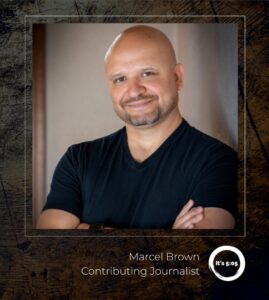September 21, 2023

In this Episode:
Marcel Brown: September 21st, 2003. After 14 years in space, eight of those as the first man-made object orbiting Jupiter, the unmanned NASA spacecraft, Galileo, is sent into the atmosphere of the giant planet.
Edwin Kwan: In an effort to reduce cybercrime, the Australian Federal Government has introduced digital identity legislation to Parliament. This will allow businesses to verify information about their customers without needing to collect information that would be useful to cybercriminals.
Katy Craig: Imagine setting up a digital tripwire and then BAM! It catches a major hacking attempt in real-time. Well, that’s exactly what happened at the U.S. State Department. Two years ago, a sharp-eyed government IT analyst set up a custom warning system within the agency’s network. This past June, that system alerted them to a Chinese-linked hack targeting their Microsoft email systems.
Hillary Coover: Gen Z, raised in the digital age, is surprisingly more vulnerable to online scams than their tech-unsavvy, Boomer grandparents. A Deloitte survey shows Gen Z members born from the late 1990s to the early 2010s are falling victim to phishing, identity theft, romance scams and cyber bullying at higher rates.
The Stories Behind the Cybersecurity Headlines
Edwin Kwan
Australian Federal Government Introduces Digital Identity Legislation
 In an effort to reduce cybercrime, the Australian Federal Government has introduced digital identity legislation to Parliament.
In an effort to reduce cybercrime, the Australian Federal Government has introduced digital identity legislation to Parliament.
This is Edwin Kwan from Sydney, Australia.
With the growing number of Australian data breaches in the last year, there has been a consensus by industry in favor of a government-backed digital ID. This will allow businesses to verify information about their customers without needing to collect information that would be useful to cybercriminals. The government said that it had thought long and hard about the principles that should guide an Australian digital ID system, and that it should be secure, convenient, voluntary, and inclusive.
The current identity system has limitations, such as the Commonwealth only being able to verify people biometrically against their passports, and not against their driver licenses or other ID documents issued by state and territory governments.
There will be four phases for the digital ID rollout. with phase one being establishing the ID in legislation.
Resources
– IT News: https://www.itnews.com.au/news/digital-id-legislation-lands-at-last-600442
– IT News: https://www.itnews.com.au/news/industry-to-gov-improve-digital-id-as-part-of-cyber-security-strategy-600332
– Bleeping Computer: https://www.bleepingcomputer.com/news/microsoft/microsoft-leaks-38tb-of-private-data-via-unsecured-azure-storage/
Katy Craig
Beijing Thwarted by Digital Tripwire
 Imagine setting up a digital tripwire and then BAM! It catches a major hacking attempt in real-time. Well, that’s exactly what happened at the U.S. State Department.
Imagine setting up a digital tripwire and then BAM! It catches a major hacking attempt in real-time. Well, that’s exactly what happened at the U.S. State Department.
This is Katy Craig in San Diego, California.
Two years ago, a sharp-eyed government IT analyst set up a custom warning system within the agency’s network. This past June, that system alerted them to a Chinese-linked hack targeting their Microsoft email systems. The alert allowed the State Department to tip off both Microsoft and the U. S. government, potentially saving a lot of data and preventing further intrusion.
While the hack did compromise some unclassified emails, the quick action likely prevented Beijing from gaining more extensive access to private communications of key U.S. officials. This incident highlights the importance of in-house cybersecurity expertise, even as many organizations are moving to external cloud services.
Christopher Painter, a former cybersecurity coordinator, summed it up well. ” In an odd way, despite all the advances we’ve had in cybersecurity, it sometimes comes down to one person seeing something that’s anomalous.”
So what’s the takeaway? It’s a reminder that in the world of cybersecurity, sometimes the hero is in a room full of people. It’s one person who had the foresight to say, ” hey, this could be a problem in the future. Let’s prepare now.”
This is Katy Craig. Stay safe out there.
Resources
– Politico: https://www.politico.com/news/2023/09/15/digital-tripwire-helped-state-uncover-chinese-hack-00115973
– NBC News: https://www.nbcnews.com/tech/security/china-based-hackers-breached-email-accounts-microsoft-says-rcna93824
Hillary Coover
Gen Z’s Battle with Online Scams
 Gen Z, raised in the digital age, is surprisingly more vulnerable to online scams than their tech-unsavvy, Boomer grandparents. A Deloitte survey shows Gen Z members born from the late 1990s to the early 2010s are falling victim to phishing, identity theft, romance scams and cyber bullying at higher rates. They’re three times more likely to be ensnared in online scams compared to Boomers, with 16% vs. 5% falling victim. Financial losses have skyrocketed from $8.2 million in 2017 to $210 million in 2022 for Gen Z victims under 20.
Gen Z, raised in the digital age, is surprisingly more vulnerable to online scams than their tech-unsavvy, Boomer grandparents. A Deloitte survey shows Gen Z members born from the late 1990s to the early 2010s are falling victim to phishing, identity theft, romance scams and cyber bullying at higher rates. They’re three times more likely to be ensnared in online scams compared to Boomers, with 16% vs. 5% falling victim. Financial losses have skyrocketed from $8.2 million in 2017 to $210 million in 2022 for Gen Z victims under 20.
Despite their awareness, Gen Z struggles to implement cybersecurity practices. The question is, why is the generation most knowledgeable about the online world also the most susceptible to scams?
Several factors contribute. Their extensive use of technology exposes them to scams more often. Familiarity bred from growing up with the internet sometimes leads to prioritizing convenience over safety. Also, current cybersecurity education often fails to resonate with their online experiences.
Gen Z’s cybersecurity practices must align with their online habits. This involves adjusting settings and practices without sacrificing convenience- making cybersecurity integral to online activities.
Experts argue that apps and platforms should play a more significant role in user protection. Ideas like sending test phishing emails and simplifying privacy settings could make a substantial difference.
Preparing Gen Z for a world rife with online scams means understanding the systems perpetuating them. It involves delving into why scams occur, who perpetuates them, and how to combat them.
Armed with this knowledge, Gen Z is poised to lead toward a safer digital world, making informed choices and championing online safety.
Resources
– Apple: https://apple.news/AdVs9-B9iSbKYuVESNnekAA
– Vox: https://www.vox.com/technology/23882304/gen-z-vs-boomers-scams-hacks
Marcel Brown
This Day, September 21, in Tech History
 This is Marcel Brown with some technology history for September 21st.
This is Marcel Brown with some technology history for September 21st.
September 21st, 1972. Texas Instruments released its first three calculators, the TI 2500, TI 3000, and TI 3500. Having invented the integrated circuit in the late 50s, Texas Instruments had a natural interest in developing devices that could use the integrated circuit. Handheld calculators seem to be a natural fit. After partnering with Canon to create the Pocketronic in 1970 and then creating their Calculator on a Chip in 1971, Texas Instruments decided to enter the handheld calculator market on its own.
While TI was not the first to market with a handheld calculator, ironically, its competitors mostly using TI components. TI’s entry into the market, brought the handheld calculator into the mainstream, and the rest is history.
September 21st, 1994. Microsoft releases version 3.5 of the Windows NT operating System code named “Daytona,” in reference to the Daytona International Speedway, version 3.5 was specifically optimized for speed, and it was released in two versions, Server and Workstation.
September 21st, 2003. After 14 years in space, eight of those as the first man-made object orbiting Jupiter, the unmanned NASA spacecraft, Galileo, is sent into the atmosphere of the giant planet. NASA decided to end Galileo’s mission in this manner in order to avoid any possibility of it colliding with one of Jupiter’s moons and potentially contaminating it with bacteria from Earth. How sanitary of them.
That’s your technology history for today. For more, tune in tomorrow and visit my website thisdayintechhistory.com.
Resources
– https://thisdayintechhistory.com/09/21










